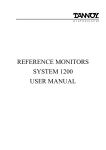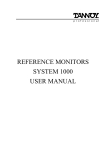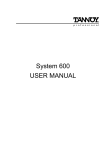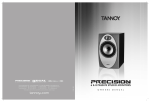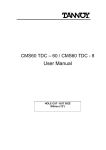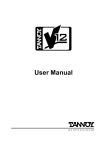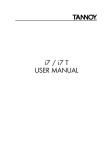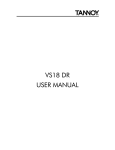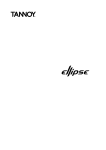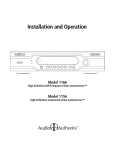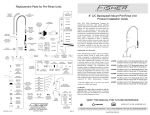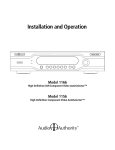Download System 800 USER MANUAL
Transcript
System 800 USER MANUAL INTRODUCTION Thank you for purchasing the Tannoy System 800 Monitors. This loudspeaker is a very compact, professional near-field reference monitor. Using an advanced Dual Concentric 8” driver, if offers the advantages of the point source operation in a very cost-effective design. The attractive octagonal shape of the cabinet with its original rounded edge corners front panel contributes to the excellent acoustic performance of the cabinet. Compared to its predecessor in the same category, this product offers extended bass capability, as well as smoother overall balance for even more transparent and fatigue-free monitoring. Designed to be located on top of the mixing console, in a landscape format, it will equally suit other situations where it can be used in portrait mode without any drawback, thanks to its point source operation. This manual is intended to provide the user with some useful advice on how to install and use the loudspeakers, as well as more technical information about how the system is designed, and its detailed specifications. The goal being that it will help to get the best results, those you are expecting, from this monitoring system. OPERATING INSTRUCTIONS Unpacking and visual checks To get the speakers out of the carton without damage open the end flaps fully and bend them right back (remember there are packed in pairs). Turn the package upside-down on the floor and lift the carton vertically up to leave the speakers resting on their packing tray. Inspect each speaker for signs of transit damage. In the unlikely event of this having occurred inform the carrier and the supplier. Keep all the packaging if damage has occurred as this will show evidence of excessive handling forces. It is also a good idea to keep the carton if possible for future transportation. Preliminary recommendation Initially we would like to give a word of warning on high sound levels, which these speakers are capable of generating over sustained periods of time. Levels over 95 dB for 8 hours per day will eventually cause permanent hearing loss. Because Tannoy Monitors have very low levels of time, amplitude and frequency distortion it is not always obvious that the sound level is high while working with them. For continuous exposure we recommend the occasional use of a sound level meter capable of integrating the sound level over a period of exposure according to noise control standards. This should be used just to check that noise levels are always within safety limits. Installing and connecting the loudspeakers. When choosing a suitable location for the monitors, bear in mind that the physical mounting of loudspeakers can have a large influence on performance. For best results the monitors should be mounted on a rigid structure, supported on four pads making contacts with the laminated panel. The use of soft pads (rubber, Sorbothane, etc..) is recommended. When used in the landscape orientation, we recommend location of the monitors so that the drive units are toed inwards, with their axes oriented towards the listening position. The distance between the two speakers should be about 1.5 to 2 metres, depending on the monitoring position. The distance between the monitoring position and each speaker should be slightly greater than the distance between the speakers. If the speakers are placed too close to each other the full stereo image may not develop, on the other hand if you place them too far apart you will notice an audible hole in the middle of the stereo image. Ensure that the console position does not obscure the direct sound radiation from the Dual Concentric drive unit when sitting down. The engineer and producer should have a clear, uninterrupted view of the monitor loudspeakers. Connection to the amplifier is made by means of a pair of banana sockets, located on the termination panel at the back of the speakers. When connecting the speakers it is essential that consistent polarity is observed. The red terminal on the loudspeaker must be connected to the red or positive terminal on the power amplifier, and the black terminal on the loudspeaker must be connected to the black, negative or ground terminal of the power amplifier. The types of cable used to connect the speakers to the power amplifier will marginally affect the sound. The cross-section area of the cable should be large enough not to affect the damping factor, and generally a cable of 2.5 mm², or greater, cross-section can be recommended. Before connecting the amplifier and the monitors, it is advisable to ensure that there is no signal present either by turning amplifiers gain down or by setting the output faders. Power amplifiers. The power amplifier should be reasonably well matched in power to the power rating of the speakers. A recommended range of power can be found in the specifications (at the end of this manual). The use of a powerful amplifier (i.e. the higher figure of the specified power range) provides headroom which is useful especially for highly dynamic programme materials. Because of the high peak power handling of the Tannoy monitors, a responsible use of even more powerful amplifiers should not represent a danger for the speakers if the amplifiers are not overdriven. SYSTEM DESCRIPTION AND PHILOSOPHY A loudspeaker design naturally divides into various parts: cabinet, drive unit(s) and crossover. The design of these parts cannot take place in isolation as they are all interdependent. Drive unit. The drive unit used in the System 800 monitors is part of the latest generation of Dual Concentric units designed by Tannoy. Among many others features, this range of drivers incorporate a dual magnet assembly, ‘tulip’ HF waveguide and injection moulded polypropylene LF cone. The design of the HF waveguide has been arrived at by making extensive use of CAD (computer aided design). It matches the acoustic source impedance at the HF diaphragm into the acoustic environment, shaping the wavefront as it travels down from the diaphragm ensuring equal path lengths to achieve a spherical wavefront. Wavefront shaping begins at the diaphragm surface and, because the compression ratio can be kept relatively low with this design, the distortions due to air nonlinearities are minimised. A hyperbolic flare has been chosen for optimum low frequency performance at the crossover point. The HF diaphragm is made from aluminium and magnesium alloy, with optimised shape and thickness providing rigid piston behaviour up to 25 kHz. The diaphragm assembly is suspended by a precision moulded, inert nitrile rubber surround. Its very narrow roll eliminates resonances below 25 kHz and provides a very stable and consistent mounting. The roll form ensures high excursions can take place if necessary yet provides a fatigue-indestructible assembly. The HF voice coil assembly incorporates a high temperature copper wire chemically bonded onto a kapton former fitting onto the outside of the HF diaphragm skirt. The thermal power handling of the voice coil is greatly increased thanks to its ferrofluid filled magnetic gap. Physically, the whole HF assembly self centre mounts onto the back of the low frequency assembly using three screws carrying with it the self-centring HF diaphragm. Production and field service is therefore virtually foolproof and extremely consistent. The LF unit uses a CNC precision injection moulded polypropylene cone, terminated by a nitrile rubber, high-compliance surround. The characteristic cone termination impedance is matched by the surround material independently of the required suspension compliance. The unit system compliance is provided by the rear suspension where the best degree of mechanical control can be provided. The shape of the LF cone has been calculated to match the HF hyperbolic waveguide ensuring the wavefront remains spherical and perpendicular to the cone surface throughout the propagation. Purpose-designed trim rings are used to blend the HF wavefront into the cabinet. This feature has been shown in our research to be the biggest single factor in providing smooth HF radiation in Dual Concentrics. The heart of the LF unit is the motor system comprising the magnet and voice coil. The choice of magnet operating point parameters, air gap flux strength, voice coil details (number of turns, resistance, winding length, diameter etc.), moving mass, dynamic compliance and drive unit radiating area presents a very complex mathematical problem where the solutions can take many different forms. Reaching the correct answers is much easier if computers can be called on to assist with solving the equations, as Tannoy do for its drivers. Cabinet. Aside the drive units, cabinet design plays a major role in the acoustic performance of a speaker system. Among the problems which can contribute to the degradation of the emitted sound field, diffractions and reflections caused by the cabinet boundaries are too often overlooked although they are the cause of most of the irregularities heard and measured in the higher frequency areas. In that respect conventional rectangular, sharp corner boxes perform especially poorly. On the other hand, the shape of the System 800 has been designed with careful attention paid regarding the sculptured front panel to provide smooth, rounded edges which minimise side diffractions. Another problem involved in cabinet design is to ensure that the box will effectively behave as neutrally as possible, ideally without interfering at all with the sound field emitted by the drive unit and the port. There are two main ways the box can get into vibration. First there can be a mechanical transfer of energy between the drive unit and the cabinet front panel. Preventing this requires the use of a rigid and stiff front baffle, which is achieved on the System 800 by a very thick and compact MDF panel. The second way the cabinet can get into vibration is by transmission from acoustical to mechanical energy. Since high acoustic pressures are present inside the cabinet this is quite likely to occur if no attention is paid in order to minimise it. Here the use of rigid panels is also helpful but, since their stiffness cannot be infinite and therefore their resonances only shifted towards higher frequencies, enough damping has to be provided in the cabinet assembly, including panels and joints. Due to its octagonal shape and its cabinet construction, the System 800 perform very well in that respect. Its shape tends to decrease the largest dimensions of each side panel, which reduce low frequency resonances, while the doubled number of side provides additional damping. In addition to the cabinet construction the volume and port tuning have been carefully calculated to give the best set of parameters for monitoring loudspeakers. There is a fundamental relationship in loudspeakers between efficiency, cabinet volume and low frequency performance given that minimal amplitude variations can be tolerated (as in monitoring situations). The set of parameters that are arrived at as a solution are inevitably a compromise and the skill of Tannoy has always been shown to be getting these particular parameters correct for the application. The Sum of the parts. The crossover is an important, sometimes difficult part of the design. However the use of an optimised, well designed drive unit makes the task easier and allows using simpler networks, which generally give better results. It is also important to point out that a very important benefit of the Dual Concentric technology is in connection with the crossover. With conventional discrete multidrivers speakers, the crossover has a dramatic effect on the speaker performance in the frequency range where the different drivers overlap, especially on off-axis response and on spatial dispersion. Actually, because of the detrimental effects resulting from the fact that they are non-coincident, the drivers should ideally work in completely split ranges of frequency. High order low and hi-pass filters are therefore required to reduce the overlap range. Apart from the fact that it makes the design more complex, requires more accurate components and increases the costs, a major drawback is that higher order filters involve increased phase and group delay distortion, which can be quite perceptible. On the other hand the low order filter used with Dual Concentric drivers achieve a smooth phase response. The integration of all the features described above is what makes the whole loudspeaker system even greater than the sum of the individual parts. SERVICING Cabinet finish. To remove marks and scuffs use a medium soft brush. If necessary, a little warm water and detergent can be used but under no circumstances use a solvent or abrasive cleaner. The surface will change colour when wet but will return to normal when dry. For touch-up of paint chips contact your local Tannoy service agent for materials and guidance. Dual Concentric driver removal. Lay the cabinet on its back. Remove the six hexagonal bolts and set aside. Ease the driver from the front of the cabinet taking care not to mark the front surface. Use a piece of stout cardboard to lever against if necessary. Remove the driver, note the polarity of the internal connections and disconnect the internal wiring. Take care not to damage the moving parts of the LF driver. To refit the driver, connect the cables from the crossover to the LF and HF terminals. Fit the driver into mounting hole, making sure that the internal connecting cables are not trapped between the HF unit and the cabinet crossbrace. Fasten the bolts finger tight and then progressively torque them down. Drive unit servicing. The HF unit may be fitted with a new diaphragm assembly or replaced as a complete assembly for speed. In either case, with the driver face down, release the three bolts securing the HF assembly and lift the HF unit vertically upwards and away from magnetic attraction caused by the LF magnet. Replace the diaphragm - it is selfcentring - or the complete unit, taking care to align the parts correctly. To refit the HF unit, hold it about 300 mm vertically above the LF magnet in both hands while resting on your elbows. Slide your elbows apart and lower the HF unit onto the back of the LF magnet. As the HF unit gets close to the magnet you will feel the magnetic fields repelling. Align the fixing holes and secure with the bolts, tightening down evenly. Do not tighten the bolts finally until you are sure the HF unit is seated correctly and the two magnet systems appear parallel. The LF unit may be re-coned in the normal way. Ease the trim ring from the rubber surround and remember to refit it. The trim ring forms an integral part of the HF dispersion system. Use only the parts and adhesive supplied in the re-cone kit. Crossover. The crossover is mounted on the rear of the terminal panel. To inspect it, remove the panel by releasing the hexagonal screws. Take care to avoid undue stress on the cables and components. To remove the crossover completely the cables must be disconnected from the drive unit. Please proceed as above to remove the drive unit. Checking the unit. The speaker can be checked using a sine wave generator. A high quality, low distortion (preferably a beat frequency) oscillator will be required to check for any buzz and rattle noise generated by the drive unit. The voltage to be applied at the speaker terminals should be about 3V rms (the speakers should be free from buzz and rattle at any audio frequency). Checking the speaker at higher levels is permissible, provided that the lower frequency of the sweep is limited according to the voltage level ; for instance with levels exceeding 10V rms the frequency should be kept above 100 Hz. List of spare parts. PART NUMBER DESCRIPTION 9900 0259 System 800 Cabinet assembly 7900 0413 Driver kit 7900 0414 Recone kit for LF unit 7600 0725 HF diaphragm assembly 6839 0313 Gasket, 8 inch driver 4529 0002 Screw M5 x 30mm hex countersunk black 6184 0043 Port tube 7300 0490 Crossover assembly & termination panel 6481 0257 System 800 User manual 6736 0300 Carton System 800 6460 0064 Moulded badge & Label Warranty No maintenance of the monitors is necessary. All components are guaranteed for a period of five years from the date of manufacture, subject to the absence of, or evidence of, misuse, overload or accidental damage. For further information please contact your dealer or the distributor in your country. If you cannot locate your distributor please contact : Customer Services Tannoy Ltd Rosehall Industrial Estate Coatbridge, Strathclyde ML5 4TF Telephone Fax 01236 420199 (UK) 01236 428230 (UK) +44 1236 420199 (International) +44 1236 428230 (International) DO NOT SHIP ANY PRODUCT TO TANNOY WITHOUT PREVIOUS AUTHORISATION. This warranty in no way affects your statutory rights. CURVES Figure 1. On axis anechoic response. Figure 2. Impedance. TECHNICAL SPECIFICATIONS System Frequency response (1) 47 Hz - 20 kHz Recommended amplifier power 60 to 180 W rms into 8 Ω Power handling Average (2) 90 W rms Nominal Impedance 8Ω Sensitivity (3) 92 dBSPL / 1 W @ 1 m Distortion < 0.8% Dispersion (@ -6dB) 90° conical Crossover frequency 1800 Hz Programme 180 W rms Cabinet Drive unit 8’’ Tannoy Dual Concentric type 2046 Low frequency design Optimised bass-reflex load, in 21 litres Cabinet construction MDF (36 mm front panel) Cabinet finish Spray ‘F’ Vinyl Cabinet dimensions (HxWxD) 275 mm x 450 mm x 267 mm Cabinet weight 10.5 kg Shipping dimensions (HxWxD) 540 mm x 695 mm x 355 mm Shipping weight 23 kg NOTES : (1) +/- 3 dB , measured at 1m in an anechoic chamber. (2) Long term power handling capacity as defined in EIA standard RS426A. (3) Averaged over specified bandwith for half-space envirronment. For anechoixc conditions the figure is to be decreased by 3 dB. Tannoy operate a policy of continuous research and development. The introduction of new materials or manufacturing methods will always equal or exceed the published specifications which Tannoy reserve the right to alter without prior notice. Please verify the latest specifications when dealing with critical applications. Declaration of Conformity The following apparatus is/are manufactured in the United Kingdom by Tannoy Ltd of Rosehall Industrial estate, Coatbridge, Scotland, ML5 4TF and conform(s) to the protection requirements of the European Electromagnetic Compatibility Standards and Directives relevant to Domestic Electrical Equipment. The apparatus is designed and constructed such that electromagnetic disturbances generated do not exceed levels allowing radio and telecommunications equipment and other apparatus to operate as intended, and, the apparatus has an adequate level of intrinsic immunity to electromagnetic disturbance to enable operation as specified and intended. Details of the Apparatus: Tannoy Monitor Loudspeaker Model Number: System 800 Associated Technical File: EMCSYS800 Applicable Standards: EN 50081-1 Emission EN 50082-1 Immunity Signed: Position: Technical Manager Tannoy Professional Date: 16th July 1998 For Tannoy Ltd Tannoy Loudspeakers are manufactured in Great Britain by : Tannoy Ltd, Rosehall Industrial Estate, Coatbridge, Strathclyde, ML5 4TF, SCOTLAND Telephone: +44 (0)1236 420199 Fax: +44 (0)1236 428230 Internet:http://www.tannoy.com Tannoy North America Inc. 335 Gage Avenue, Suite 1, Kitchener, Ontario, CANADA, N2M 5E1 Telephone: (519) 745 1158 Fax: (519) 745 2364 Tannoy Nederland BV, Anthonetta Kuijlstraat 19, 3066 GS, Rotterdam THE NETHERLANDS Telephone: (010) 2860554 Fax: (010) 2860431 Issue 2 Part No. 6481 0244












